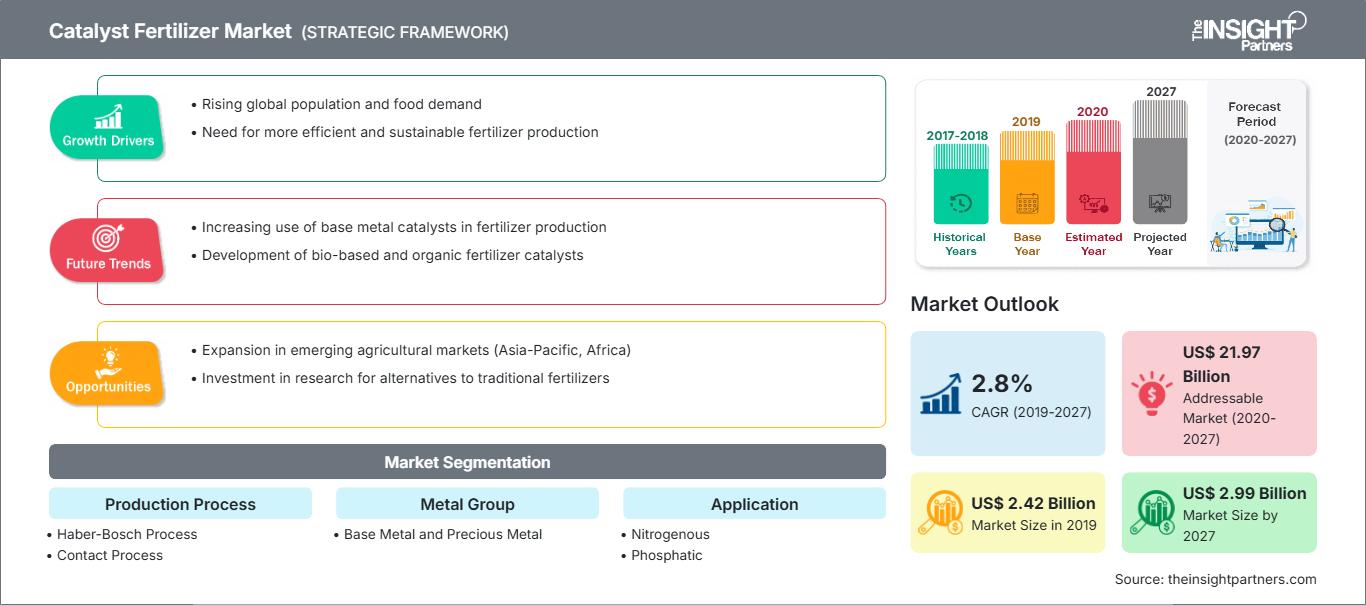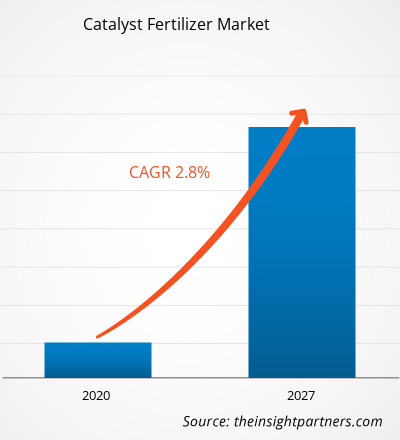[研究报告]2019年催化剂肥料市场价值为24.2332亿美元,预计到2027年将达到29.9238亿美元;预计2020年至2027年的复合年增长率为2.8%。
催化剂主要用于使所需反应在尽可能短的时间内尽可能接近可逆反应的平衡点。它们加快正向和逆向反应的速率,从而更快地达到平衡,并且在不参与化学反应的情况下保持不变。催化剂可以提高产量并提高工艺效率,同时降低成本。因此,我们非常重视推广活性更高的催化剂,以减少对环境的影响并延长其使用寿命。根据生产工艺,催化肥料市场可分为哈伯-博施法、接触法和其他法。
2019年,亚太地区在全球催化肥料市场中占据最大份额。该地区催化肥料市场的增长主要归因于对更高作物产量的需求增长。人们对土地效率的关注度不断提高,这要求使用催化肥料来生产氮肥等矿物肥料。此外,由于人口增长带来的粮食安全问题日益严重,该地区在全球化肥消费中占据了相当大的份额。中国和印度等人口增长率较高的国家正在增加对粮食的需求。另一方面,由于城市化和工业化,可耕地面积正在减少,这迫使农民或作物种植者增加化肥的消耗。长期以来,人们一直使用化肥来提高作物的产量。这种充足均衡的化肥使用有助于利用现有的可耕地养活不断增长的人口。作物集约化和更高土地利用效率的需求增加了亚太地区对催化剂肥料等增值肥料的需求。
自定义此报告以满足您的要求
您将免费获得任何报告的定制,包括本报告的部分内容,或国家级分析、Excel 数据包,以及为初创企业和大学提供超值优惠和折扣
催化剂肥料市场: 战略洞察

-
获取本报告的主要市场趋势。这个免费样本将包括数据分析,从市场趋势到估计和预测。
催化剂肥料用于种植各种作物,但施用量取决于土壤肥力,土壤肥力是通过土壤测试测得的。液体肥料的使用呈上升趋势,因为与干性催化剂肥料相比,它们更省力。液体肥料可作为灌溉系统和作物行间起始肥施用,有助于有效利用植物养分,并最大限度地减少环境问题。由于人口快速增长带来的粮食需求不断增加,对液体催化剂肥料的需求也随之增加。由于对粮食的需求增加以及对地下水资源枯竭的担忧,对氮、钾和磷肥的需求增加,这有利于液体催化剂肥料市场的发展。欧洲肥料制造协会 (EMA) 正在采取各种措施,以实施产品管理计划,旨在利用液体催化剂肥料提高农业生产力。此外,美国植物食品管理协会 (AAPFCO) 引领了北美作物生长促进剂先进模型的引入。该协会制定了检验技术标准,并鼓励采用有效且合理的耕作方法,这有利于液体催化剂肥料市场的发展。此外,中国和印度等一些农业大国的农民正致力于开发适用于任何气候条件的土壤保护产品;因此,采用能够均匀提供氮、磷、钾营养的先进技术将推动液体催化剂肥料市场的发展。叶面施肥通过叶片为植物缺乏所需营养的部位以及受到胁迫的根部提供营养。如今,农民逐渐认识到液体催化剂肥料相对于干肥料的优势,这有力地促进了液体催化剂肥料在全球范围内的广泛应用。
生产工艺洞察
基于生产工艺的催化剂肥料市场可细分为哈伯-博施法、接触法和其他工艺。预计哈伯-博施法将在2020年至2027年期间实现最快的复合年增长率。哈伯法也称为哈伯-博施法,是一种人工固氮工艺,是当今氨生产的主要工业工序之一。该工艺在高温高压下,利用金属催化剂将大气中的氮气与氢气发生反应,转化为氨(NH3)。哈伯-博施法依靠催化剂加速N2的加氢。这些催化剂是“非均相”的,这意味着它们是与气态试剂相互作用的固体。催化剂通常由细分散的铁与含有助催化剂的氧化铁载体结合而成,助催化剂可能包括氧化铝、氧化钾、氧化钙和氧化镁。
金属类别洞察
基于金属类别的催化剂肥料市场细分为贱金属和贵金属。预计在2019年至2027年的预测期内,贱金属细分市场将以最快的速度增长。与金或银等贵金属不同,贱金属基本上是一种常见且廉价的金属。炼金术士长期以来的目标是将贱金属(低品位)转化为贵金属。钴、铁和镍催化剂与钯催化剂同时进行了碳-碳键形成的研究,研究发现,在合适的配体负载下,镍和钴可以实现高效的偶联反应,从而在不饱和体系中实现碳-氢键的正式加成。镍、钼、钴、铑、铂、钯等金属被广泛用作化工、石化和化肥工业的催化剂。它们通常主要通过沉淀或浸渍工艺负载在氧化铝和二氧化硅等多孔材料上。螯合剂是最有效的提取物,可以添加到土壤淋洗液中,以增强从污染土壤中提取重金属的效果。螯合剂在土壤清理中的主要优点包括金属提取效率高、所形成的金属配合物热力学稳定性高、金属配合物的溶解性好、螯合剂在土壤上的吸附性低,但很少有人尝试用螯合剂从废催化剂中提取金属。
科莱恩、杜邦公司、Haldor Topsör、庄信万丰等是全球催化剂肥料市场的主要参与者。这些公司正在实施新的产品开发和并购战略,以扩大客户群并在全球范围内获得显著的市场份额,从而使参与者能够在全球范围内维护自己的品牌名称。
报告重点
- 全球催化肥料市场的渐进式行业趋势有助于参与者制定有效的长期战略
- 发达市场和发展中市场采用的业务增长战略
- 2017 年至 2027 年全球催化肥料市场的定量分析
- 各行业全球催化肥料需求的估计
- PEST 分析,以说明行业买家和供应商预测市场增长的有效性
- 了解竞争激烈的市场状况和全球催化肥料需求的最新发展
- 市场趋势和前景,以及推动和抑制全球催化肥料市场增长的因素
- 通过了解支撑全球催化肥料市场增长商业利益的战略来进行决策过程
- 全球催化不同市场节点的肥料市场规模
- 全球催化剂肥料市场的详细概述和细分,以及其行业动态
- 全球不同地区的催化剂肥料市场规模及良好的增长机会
催化剂肥料市场区域洞察
The Insight Partners 的分析师已详尽阐述了预测期内影响催化剂肥料市场的区域趋势和因素。本节还讨论了北美、欧洲、亚太地区、中东和非洲以及南美和中美洲的催化剂肥料市场细分和地域分布。
催化剂肥料市场报告范围
| 报告属性 | 细节 |
|---|---|
| 市场规模 2019 | US$ 2.42 Billion |
| 市场规模 2027 | US$ 2.99 Billion |
| 全球复合年增长率 (2019 - 2027) | 2.8% |
| 历史数据 | 2017-2018 |
| 预测期 | 2020-2027 |
| 涵盖的领域 |
By 生产工艺
|
| 覆盖地区和国家 |
北美
|
| 市场领导者和主要公司简介 |
|
催化剂肥料市场参与者密度:了解其对业务动态的影响
催化剂肥料市场正在快速增长,这得益于终端用户需求的不断增长,而这些需求的驱动因素包括消费者偏好的演变、技术进步以及对产品优势的认知度的提升。随着需求的增长,企业正在扩展产品线,不断创新以满足消费者需求,并抓住新兴趋势,从而进一步推动市场增长。

- 获取 催化剂肥料市场 主要参与者概述
- 哈伯-博施法
- 接触法
- 其他
全球催化肥料市场,按金属类别划分
- 贱金属
- 贵金属
全球催化肥料市场,按应用划分
- 氮肥
- 磷酸盐肥
- 其他
公司简介
- 科莱恩
- 杜邦公司
- Haldor Topsöe
- 庄信万丰
- LKAB Minerals AB
- PDIL
- Quality Magnetite
- QuantumSphere, Inc.
- Axens
- Agricen
- 历史分析(2 年)、基准年、预测(7 年)及复合年增长率
- PEST和SWOT分析
- 市场规模、价值/数量 - 全球、区域、国家
- 行业和竞争格局
- Excel 数据集
近期报告
客户评价
购买理由
- 明智的决策
- 了解市场动态
- 竞争分析
- 客户洞察
- 市场预测
- 风险规避
- 战略规划
- 投资论证
- 识别新兴市场
- 优化营销策略
- 提升运营效率
- 顺应监管趋势






















 获取免费样品 - 催化剂肥料市场
获取免费样品 - 催化剂肥料市场